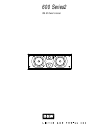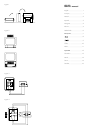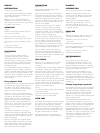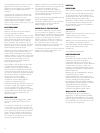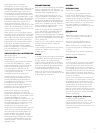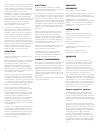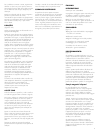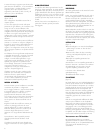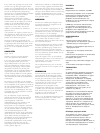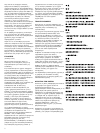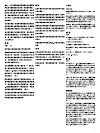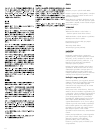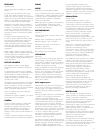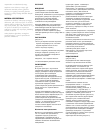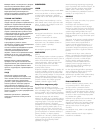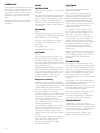
1
ENGLISH
INTRODUCTION
Thank you for choosing B&W.
Please read this manual fully before unpacking
and installing the product. It will help you to
optimise its performance.
B&W maintains a network of dedicated
distributors in over 60 countries who will be
able to help you should you have any problems
your dealer cannot resolve.
UNPACKING
(figure 1)
•Fold the carton flaps right back and invert
the carton and contents.
•Lift the carton clear of the contents.
•Remove the inner packing from the product.
We suggest you retain the packing for future
use.
Check in the carton for:
•4 self-adhesive rubber pads.
POSITIONING
(figure 2)
If using a projection television with an
acoustically transparent screen, place the
speaker behind the center of the screen.
Otherwise position it directly above or below
the screen, whichever is closest to ear level.
Align the front of the speaker approximately
level with the screen.
Fix the 4 self-adhesive pads to the base of
the speaker. They give a degree of vibration
isolation, especially useful if placing the speaker
directly on top of a fairly flimsy television. The
flat area on top of the television may be smaller
than the base of the speaker, so position the
feet accordingly.
Stray magnetic fields
The speaker drive units are magnetically shielded
such that the stray magnetic field outside the
boundaries of the cabinet, except the front,
is too low to cause distortion of the television
picture in the vast majority of cases.
There are, however, some extremely sensitive
televisions – some that even have to be adjusted
according to their alignment with the earth’s
magnetic field. If you have a problem, first
de-gauss the television set with the speaker in
place. Some have a button specially for this
purpose. If not, switch off the set at the mains
for 15 minutes and switch on again. Merely
putting the set into standby mode is not
sufficient.
If you still have a problem, try moving the
speaker either forwards or backwards a little
to get a more favourable juxtaposition, or space
the speaker further from the television until the
distortion disappears.
Because of the higher stray magnetic field in
front of the speaker, we recommend you keep
magnetically sensitive articles (computer discs,
audio and video tapes, swipe cards and the
like) at least 0.2m from the speaker.
CONNECTIONS
(figures 3 & 4)
All connections should be made with the
equipment switched off.
There are 2 pairs of terminals at the back of
the speaker which permit bi-wiring if desired.
On delivery, the separate pairs are connected
together with high-quality links for use with a
single 2-core cable. For single cable connection,
leave the links in place and use either pair of
terminals on the speaker.
Ensure the positive terminal on the speaker
(marked + and coloured red) is connected
to the positive output terminal of the amplifier
and negative (marked – and coloured black) to
negative. Incorrect connection can result in poor
imaging and loss of bass (figure 3).
To bi-wire, remove the links by loosening the
terminal caps and use a separate 2-core cable
from the amplifier to each pair of terminals.
This can improve the resolution of low-level
detail. Observe the correct polarity as before.
When bi-wiring, incorrect connection can also
impair the frequency response (figure 4).
Ask your dealer for advice when choosing
cable. Keep the total impedance below the
maximum recommended in the specification and
use a low inductance cable to avoid attenuation
of the highest frequencies.
FINE TUNING
Before fine tuning, double check that all the
connections in the installation are correct
and secure.
For greatest realism in home theatre installations
it is important to balance the speakers and
adjust the acoustic image to match the size of
the screen. With smaller screens it may be more
realistic to have the left and right speakers closer
together than you might for audio alone.
Adjust the levels of the three front speakers to get
a smooth transition of sounds as they pan across
the screen. Adjust the level of the surround
speakers so that, except for special effects, your
attention is not unduly attracted
to them.
Sit in all likely listening positions when deciding
on the optimum levels.
Consult your decoder manual for further
information on how to set the levels.
AFTER CARE
The cabinet surface usually only requires dusting.
If you wish to use an aerosol cleaner, remove
the grille first by gently pulling it away from
the cabinet. Spray onto the cleaning cloth, not
directly onto the cabinet. The grille fabric may
be cleaned with a normal clothes brush whilst
the grille is detached from the cabinet.
Avoid touching the drive unit diaphragms,
especially the tweeter, as damage may result.
FRANÇAIS
INTRODUCTION
Nous vous remercions d’avoir choisi B&W.
Veuillez lire attentivement l’ensemble de ce
document avant de déballer et de raccorder
votre matériel. Il vous aidera à obtenir les
meilleurs résultats.
B&W entretient un réseau de distributeurs
officiels dans plus de 60 pays ; ils sont en
mesure de vous aider au cas où vous
rencontreriez des difficultés que votre revendeur
ne pourrait résoudre.
DEBALLAGE
(figure 1)
•Repliez totalement les rabats du carton puis
retournez l’emballage avec son contenu.
•Soulevez le carton pour le vider de
son contenu.
•Retirez l’emballage intérieur.
Nous vous suggérons de conserver l’emballage
pour une utilisation ultérieure.
Vérifiez à ce que le carton contient :
•4 tampons auto-adhésifs.
POSITIONNEMENT
(figure 2)
Si vous utilisez un écran de projection
acoustiquement transparent, disposez votre
enceinte derrière lui et bien au centre, sinon
placez-la directement au-dessous ou au-dessus,
la face avant alignée sur l’écran et toujours au
plus près de la hauteur des oreilles.
Fixez les 4 tampons auto-adhésifs sous les
enceintes. Ils procurent une certaine isolation
mécanique surtout lorsque l’enceinte est posée
sur le dessus d’un téléviseur peu rigide. Si la
face supérieure de celui-ci est moins large que la
base de l’enceinte, disposez les tampons en
conséquence.
Champs magnétiques parasites
Les transducteurs de cette enceinte sont blindés
afin d’éviter les fuites magnétiques au-delà des
limites de l’ébénisterie, excepté par la face
avant. Les rayonnements restent, cependant,
suffisamment faibles pour ne pas créer de
distorsions sur l’image du téléviseur dans la plus
grande majorité des cas.
Il existe des téléviseurs très sensibles aux
rayonnements, principalement ceux qui sont
ajustés en tenant compte du champ magnétique
terrestre. Si vous rencontrez un problème avec
l’un de ces appareils, commencez par le
démagnétiser, l’enceinte étant en place. Certains
téléviseurs disposent d’une commande prévue
à cet effet ; si le vôtre n’en dispose pas, coupez
l’alimentation du téléviseur pendant au moins
15 minutes puis remettez-le sous tension.
Généralement, une simple mise en veille ne
suffit pas.



